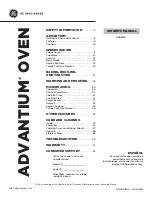
6
door hook
door release button
pilot switch
screw
latch switch
screw
Fig.2-5£¨b£©
transformer
4
S
5
S
timer & power motor
Fig.2-6
230V
There fixed hooks on the oven door, and opened two rectangle hole at the corresponding place at the right of the
oven and the hook. Inside each rectangle hole, there fixed a micro switch. When the oven door closed, the two
hook on it would insert into the rectangle hole, and just push down several micro switches. At that time, S1, S2
are closed, S3 is cut off, and the microwave oven is under preparation of working. To that mechanical control
microwave oven, no sooner you turn the time switch to set the heating time than the power would be supplied to
the back to start the oven. To those touch control microwave oven, hardly do you set the heating time and power,
and touch the start button when the power would supplied to the back to start the oven. When press down the
door release button, S1, S2 are cut off, S3 is closed, and the microwave oven would stop operating immediately.
Provided due to some man - made or the appliance itself reasons, when the door is open, S1, S2 are closed, due
to the pilot switch (S3) still at conducted condition would make the 230V voltage short-circuited and fused the
fuse, and will never let the microwave oven working when the door is open. From this we can understand the
function of the interlock switch is when the door is
unclosed, the oven wouldn’t work, when the door is
opened when the oven is working, it would stop the
working immediately (FIG.2-5b).
2
2
.
.
4
4
.
.
2
2
T
T
I
I
M
M
E
E
A
A
N
N
D
D
P
P
O
O
W
W
E
E
R
R
D
D
I
I
S
S
T
T
R
R
I
I
B
B
U
U
T
T
O
O
R
R
Time and power distributor is mainly composed of timer
motor and two sets of gear switch S4 and S5. When
the timer is at zero position, the gear switches are cut
off, when the heating time is settled, the gear switch is
closed. When started the oven, the time motor starts
working. When it reaches the settled time, it would cut
off the gear switch (s4) to step the oven working. The
gear switch (S5) is designed for controlling the output
of the microwave oven, actually for controlling the
output of the magnetron. It mainly by the method which
make the magnetron working internally at the same
working point to change the output of the magnetron.
This method was called “CONDUCTION RATIO
CONTROL”. But there is another method which is
called “ELECTRIC LEVEL CONTROL” which is
through changing the working point (such as anode
voltage or magnetic field) to change the output of the
magnetron. Because of conduction ratio control
method is low cost, high function and high reliability, it is widely used for those microwave oven which have the
power control function.
FIG.3-1 is the power control circuit diagram of brand microwave oven, WP700. This is a typical instance of
conduction ratio control. This oven adopt time and power controller as a whole. When a 230V, 50Hz alternating
current is inputted, the time and power motor is always at working condition. At the FIG.2-7, S5 is always
conducted. Made the S5 working 30 seconds as a circle, the conduct time can be successively adjusted from 5
seconds to 30 seconds. When power select switch is set at “HIGH”, S5 is always conducted, the output of the
microwave oven is 700W(full power) when the power select switch is set at defrost position, S5 would conduct for
14.4 seconds, and cut off for 15.5 seconds, and the average output of the oven is 336W.
2
2
.
.
4
4
.
.
3
3
T
T
H
H
E
E
R
R
M
M
A
A
L
L
C
C
U
U
T
T
O
O
U
U
T
T
Thermal cutout actually is a thermal sensor switch, usually, it is fixed on the shell of the magnetron, and series
connected with the primary circuit of the magnetron to control the power input. At normal condition, the thermal
cutout is always conducted (FIG.2-8). When something wrong with the cooling system that cause some abnormal
conditions, such as molding or thermal breakdown, which made the temperature of the magnetron reach the limit
value. Then, the thermal cutout would work to turn off the power to prevent the magnetron from being damaged.
2
2
.
.
4
4
.
.
4
4
H
H
E
E
A
A
T
T
I
I
N
N
G
G
C
C
H
H
A
A
M
M
B
B
E
E
R
R








































